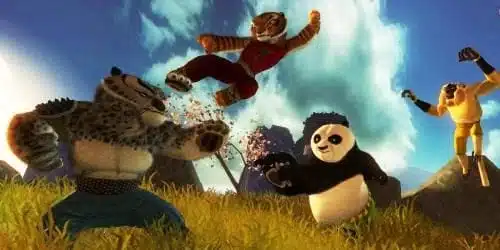
Talking movie animals are great. Do you know why talking movie animals are great? Because talking movie animals offer a glimpse at a world unfettered by human fingers, a world where humans haven’t come around to make things complicated and boring yet. Despite the fact that the walking, talking animals of Kung Fu Panda share so many of their most identifiable traits with humans, there still exists the simple fact that they don’t carry the baggage of, say, racism, sexism, and corporate greed with them into the story that they inhabit. Despite the fact that they walk, talk, and live in a world similar to the humans who voice them, they are still driven by honor, duty, ambition, and the pursuit of joy — something that can be said for the good animals and the evil ones in the story of a food-loving panda suddenly thrust into a life of so much more.
As such, I suppose it should follow that talking video game animals are just as appealing, but no! Ratatouille was a transcendent little film, perhaps the most touching Pixar effort yet, at least for adult viewers. The game? Mostly rote and trite, if adequate as far as movie tie-ins go. Even with the pedigree of a fairly excellent movie to pair up with, there’s no guarantee that a game is going to be any good, especially given that anthropomorphic animals don’t seem nearly as unusual in video games as they do in film.
Happily, the video game iteration of Kung Fu Panda is surprisingly good.
Despite the presence of lovingly rendered characters and a type of gameplay that’s been pretty darn reliable since at least Crash Bandicoot and Super Mario 64, it might be easy to dismiss the video game version of Kung Fu Panda, given that it basically takes the form of pretty much every kids’ movie adaptation of the last five years or so (other than maybe Cars): Run around in a series of linear levels, defeating baddies, jumping around obstacle courses, and figuring out how not to get killed for as long as possible. As usual, there are a few little tweaks to the formula that give the game its outward personality. For example, since he’s a panda, our hero Po gets to roll around in service of either bad guy beating or difficult terrain traversing. You occasionally get to play as other characters, which keeps things a little bit fresh. Quick time events are used judiciously and sparingly, endearing themselves to younger players by keeping the button patterns constant (unlike, for example, the Bee Movie game, which randomized their QTEs, making things very difficult for the kids). Still, it looks and plays an awful lot like any other movie adaptation.
Where things get interesting is in the use and reliance on special moves and techniques, something that doesn’t really come into play all that much unless you are playing the not-really-for-kids “Dragon Warrior” mode. The easy and medium modes in Kung Fu Panda, well, they’re button mashers that don’t take a heck of a lot of skill. “Dragon Warrior”, on the other hand, is like the kids’ movie game equivalent of Ninja Gaiden — that is, it’s freakin’ hard.
(Aside: When did it become okay to say “freakin'” in a kids’ movie/game? I mean, I guess it’s not a cuss word, but should kids be learning the cuss word substitutes before they have even had much exposure to the actual naughty word?)
Granted, as a gamer who is actually a parent of someone in the target audience of Kung Fu Panda, my skills at the high-flying, technique-based ninja play in games like the recently-released Ninja Gaiden 2 aren’t exactly what they used to be. Still, I certainly didn’t expect it to take me a cool ten tries to get past the boss of the very first level of the game in “Dragon Warrior” mode. It’s actually really refreshing to find this kind of difficulty in what is ostensibly a kids’ game, offering something for the “serious” gamer on top of the play designed to placate the kiddies for a few hours with familiar images and lowbrow humor. That the Xbox 360 version of the game contains a significant number of achievements unlockable only in “Dragon Warrior” mode further sweetens the motivation to give it a go.
Combine “Dragon Warrior” mode with lush, surprisingly detailed settings and voice actors who, while only imitations of those in the movie itself, do a fine job with the material they are given (the Jack Black voice double is particularly impressive), and Kung Fu Panda actually has a lot going for it.
Let’s keep from getting carried away — this is not Ninja Gaiden, and for the most part, it’s not even Crash Bandicoot (you know, when Crash was still new and fresh and awesome to play). Kung Fu Panda, try as it may to go beyond the implied shackles of the video game adaptation, is still trapped by its source material and the deadlines of a project team tasked to make a game for the sake of a movie cash-in. The enemies are repetitive, there are glitches aplenty to be found (particularly when jumping near cliffs and walls), and it’s a very short game. Still, a couple of thrown bones to the so-called “core gamer” make Kung Fu Panda one of the few games that teens and the little squirts they’re babysitting might just be able to enjoy together. Even better, my affection for talking movie animals seems just a little bit more justified.

